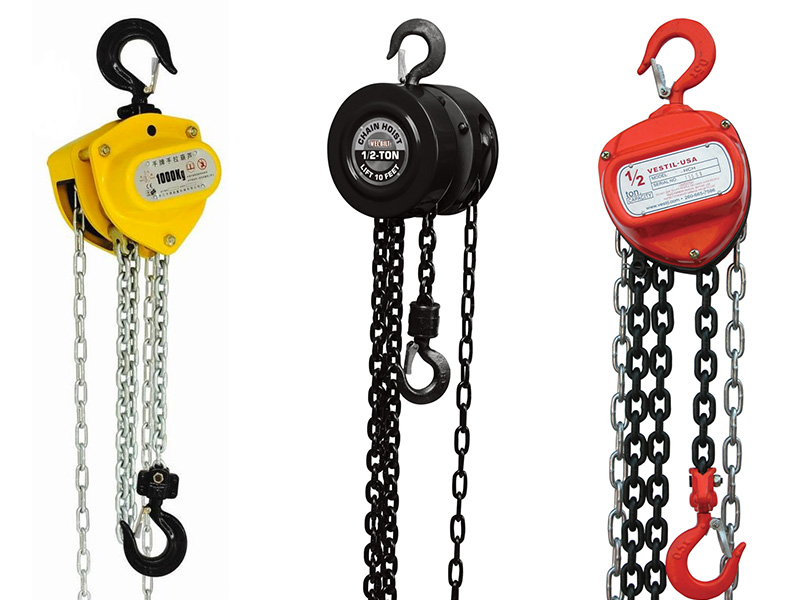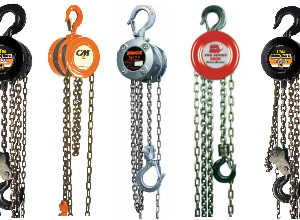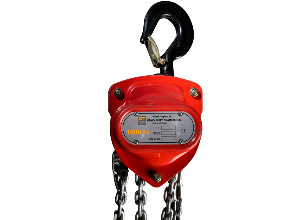How a manual chain hoist works?
From what parts a manual chain hoist consists
Manual chain hoist is a pretty simple device considering the large amount of weight such a tool can lift. Chain hoists are made from durable, high grade steel to ensure safety and reliability when lifting couple of tons heavy loads. Manual chain hoist can be separated in three different part categories: lifting chains, lifting mechanism and hooks.
Chain hoist has got two chain loops – hand chain and lifting chain. Hand chain sits on a wheel located in the lifting mechanism, it needs to be pulled by hand in order to lift a load. The wheel inside the lifting mechanism has got special pockets that allow the hand chain to move the wheel. Lifting chain also loops the lifting mechanism and lifts or lowers a load. At the end of the chain there is a grab hook, where you can attach lifting chains or slings, a load leveler or load itself. There is also a hook on the top of the chain hoists housing. This hook is used to attach the hoist to a ceiling mount, trolley system or other construction that can withstand the weight a hoist will lift. Most chain hoists have swivel hooks, meaning that they can be turned 360 degrees around to allow for easier mounting. The lifting mechanism consists of a cog, axle, drive shaft, gears and sprockets. There is also a chain stopper or brake on most chain hoists that prevents load from lowering under a load.
How a manual chain hoist works
The physics behind a chain hoist are very simple and have been used for lifting heavy objects for a long time. Chain hoist uses a mechanical advantage to transform small force over a long distance to large force over a short distance, this is possible by using multiple larger and smaller gears in the chain hoist mechanism.
To lift a load, chain hoist operator needs to pull down the hand chain, this turns the cog and axle which goes trough the lifting mechanism. Inside the lifting mechanism are multiple gears which increase the mechanical work applied when pulling the hand chain for dozen times using gear ratio, allowing to easily lift loads with multiple ton capacity.
So when the hand chain is pulled, the cog which is rotated by the hand chain turns the drive shaft and gears which turn the load chain sprocket, this also rotates the load chain that is looped over the load chain sprocket and lifts a load. Larger gears move slower than smaller gears, but create more force, this is why chain hoist lifts load very slowly when compared to a hydraulic hoist. At the end of the lifting chain is a grab hook, which allows to easily attach and detach a load. Also, most chain hoist lifting mechanisms have a ratchet or braking system that prevents the load from slipping back, but allows to lower a load by pulling the other side of the hand chain.
Manual chain hoist in comparison with other hoist types for engine lift
Chain hoists have different uses, for example in construction sites, shops, warehouses, also in car service stations and other application, where precise lifting is required.
The disadvantages of manual chain hoists for engine lifting are:
- they are slower than other type of hoists;
- they have special requirements for installation areas, which limits places these hoists can be used, in opposite hydraulic hoists just need a solid and level ground.
However, there are also some advantages for using manual chain hoists for engine lifting:
- they don’t need electricity, oil or other additional resources to work;
- they are cheaper than electric or hydraulic hoists;
- they are simple to use and easy to repair and maintain.
Here is a video illustrating the lifting mechanism of a manual chain hoist
- Floor Jack Storage Ideas and Tips - November 19, 2019
- Tips for Using a Car Jack - November 12, 2019
- How Often Should You Wash Your Car in the Winter? - November 5, 2019



what are the various reasons for hand chain to come out of Hand chain wheel?
Once when our workers were pulling the hand chain to lower the grab hook, hand chain experienced additional load and one of the links of the hand chain got opened . Entire chain fell down. But no injury.
One of the most common reasons why that happens is because people apply too much force to the chain as well as overload the hoist past its capacity. So try to adhere to the payload weight of your hoist. And pull the chan nice and steady, keeping your grip loose on the pull chain and letting the hoist do the work for you. This way you will ensure that the hoist and the chain links stay in good condition. And that there are no more accidents of the chain falling down.